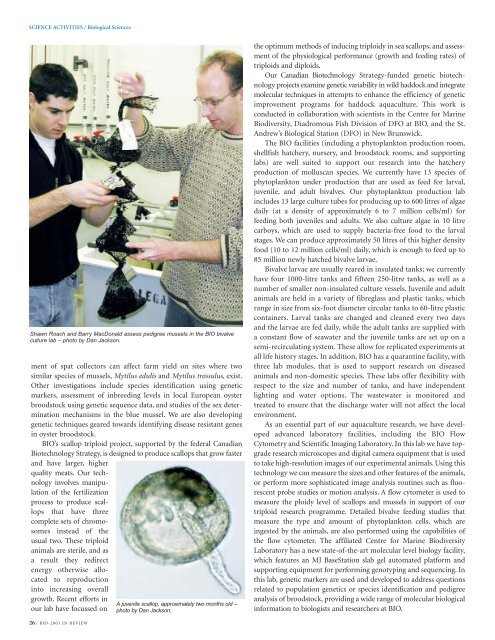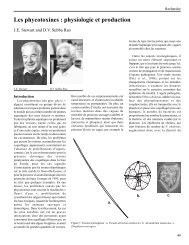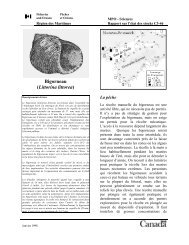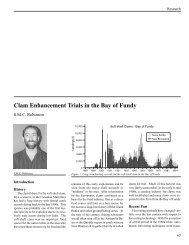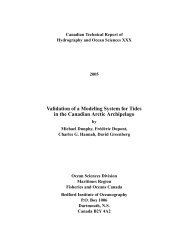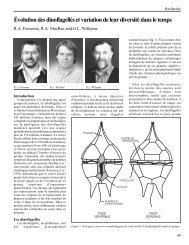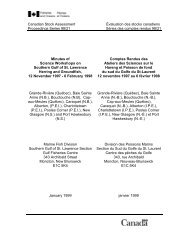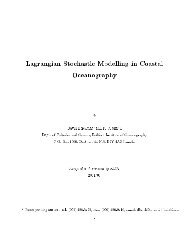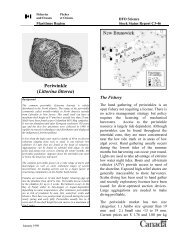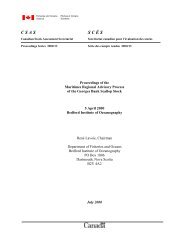bedford institute of oceanography 2001 in review - Région des ...
bedford institute of oceanography 2001 in review - Région des ...
bedford institute of oceanography 2001 in review - Région des ...
You also want an ePaper? Increase the reach of your titles
YUMPU automatically turns print PDFs into web optimized ePapers that Google loves.
SCIENCE ACTIVITIES / Biological SciencesShawn Roach and Barry MacDonald assess pedigree mussels <strong>in</strong> the BIO bivalveculture lab – photo by Dan Jackson.ment <strong>of</strong> spat collectors can affect farm yield on sites where twosimilar species <strong>of</strong> mussels, Mytilus edulis and Mytilus trossulus, exist.Other <strong>in</strong>vestigations <strong>in</strong>clude species identification us<strong>in</strong>g geneticmarkers, assessment <strong>of</strong> <strong>in</strong>breed<strong>in</strong>g levels <strong>in</strong> local European oysterbroodstock us<strong>in</strong>g genetic sequence data, and studies <strong>of</strong> the sex determ<strong>in</strong>ationmechanisms <strong>in</strong> the blue mussel. We are also develop<strong>in</strong>ggenetic techniques geared towards identify<strong>in</strong>g disease resistant genes<strong>in</strong> oyster broodstock.BIO’s scallop triploid project, supported by the federal CanadianBiotechnology Strategy, is <strong>des</strong>igned to produce scallops that grow fasterand have larger, higherquality meats. Our technology<strong>in</strong>volves manipulation<strong>of</strong> the fertilizationprocess to produce scallopsthat have threecomplete sets <strong>of</strong> chromosomes<strong>in</strong>stead <strong>of</strong> theusual two. These triploidanimals are sterile, and asa result they redirectenergy otherwise allocatedto reproduction<strong>in</strong>to <strong>in</strong>creas<strong>in</strong>g overallgrowth. Recent efforts <strong>in</strong>our lab have focussed onA juvenile scallop, approximately two months old –photo by Dan Jackson.the optimum methods <strong>of</strong> <strong>in</strong>duc<strong>in</strong>g triploidy <strong>in</strong> sea scallops, and assessment<strong>of</strong> the physiological performance (growth and feed<strong>in</strong>g rates) <strong>of</strong>triploids and diploids.Our Canadian Biotechnology Strategy-funded genetic biotechnologyprojects exam<strong>in</strong>e genetic variability <strong>in</strong> wild haddock and <strong>in</strong>tegratemolecular techniques <strong>in</strong> attempts to enhance the efficiency <strong>of</strong> geneticimprovement programs for haddock aquaculture. This work isconducted <strong>in</strong> collaboration with scientists <strong>in</strong> the Centre for Mar<strong>in</strong>eBiodiversity, Diadromous Fish Division <strong>of</strong> DFO at BIO, and the St.Andrew’s Biological Station (DFO) <strong>in</strong> New Brunswick.The BIO facilities (<strong>in</strong>clud<strong>in</strong>g a phytoplankton production room,shellfish hatchery, nursery, and broodstock rooms, and support<strong>in</strong>glabs) are well suited to support our research <strong>in</strong>to the hatcheryproduction <strong>of</strong> molluscan species. We currently have 13 species <strong>of</strong>phytoplankton under production that are used as feed for larval,juvenile, and adult bivalves. Our phytoplankton production lab<strong>in</strong>clu<strong>des</strong> 13 large culture tubes for produc<strong>in</strong>g up to 600 litres <strong>of</strong> algaedaily (at a density <strong>of</strong> approximately 6 to 7 million cells/ml) forfeed<strong>in</strong>g both juveniles and adults. We also culture algae <strong>in</strong> 10 litrecarboys, which are used to supply bacteria-free food to the larvalstages. We can produce approximately 50 litres <strong>of</strong> this higher densityfood (10 to 12 million cells/ml) daily, which is enough to feed up to85 million newly hatched bivalve larvae.Bivalve larvae are usually reared <strong>in</strong> <strong>in</strong>sulated tanks; we currentlyhave four 1000-litre tanks and fifteen 250-litre tanks, as well as anumber <strong>of</strong> smaller non-<strong>in</strong>sulated culture vessels. Juvenile and adultanimals are held <strong>in</strong> a variety <strong>of</strong> fibreglass and plastic tanks, whichrange <strong>in</strong> size from six-foot diameter circular tanks to 60-litre plasticconta<strong>in</strong>ers. Larval tanks are changed and cleaned every two daysand the larvae are fed daily, while the adult tanks are supplied witha constant flow <strong>of</strong> seawater and the juvenile tanks are set up on asemi-recirculat<strong>in</strong>g system. These allow for replicated experiments atall life history stages. In addition, BIO has a quarant<strong>in</strong>e facility, withthree lab modules, that is used to support research on diseasedanimals and non-domestic species. These labs <strong>of</strong>fer flexibility withrespect to the size and number <strong>of</strong> tanks, and have <strong>in</strong>dependentlight<strong>in</strong>g and water options. The wastewater is monitored andtreated to ensure that the discharge water will not affect the localenvironment.As an essential part <strong>of</strong> our aquaculture research, we have developedadvanced laboratory facilities, <strong>in</strong>clud<strong>in</strong>g the BIO FlowCytometry and Scientific Imag<strong>in</strong>g Laboratory. In this lab we have topgraderesearch microscopes and digital camera equipment that is usedto take high-resolution images <strong>of</strong> our experimental animals. Us<strong>in</strong>g thistechnology we can measure the sizes and other features <strong>of</strong> the animals,or perform more sophisticated image analysis rout<strong>in</strong>es such as fluorescentprobe studies or motion analysis. A flow cytometer is used tomeasure the ploidy level <strong>of</strong> scallops and mussels <strong>in</strong> support <strong>of</strong> ourtriploid research programme. Detailed bivalve feed<strong>in</strong>g studies thatmeasure the type and amount <strong>of</strong> phytoplankton cells, which are<strong>in</strong>gested by the animals, are also performed us<strong>in</strong>g the capabilities <strong>of</strong>the flow cytometer. The affiliated Centre for Mar<strong>in</strong>e BiodiversityLaboratory has a new state-<strong>of</strong>-the-art molecular level biology facility,which features an MJ BaseStation slab gel automated platform andsupport<strong>in</strong>g equipment for perform<strong>in</strong>g genotyp<strong>in</strong>g and sequenc<strong>in</strong>g. Inthis lab, genetic markers are used and developed to address questionsrelated to population genetics or species identification and pedigreeanalysis <strong>of</strong> broodstock, provid<strong>in</strong>g a wide range <strong>of</strong> molecular biological<strong>in</strong>formation to biologists and researchers at BIO.26 / BIO-<strong>2001</strong> IN REVIEW


